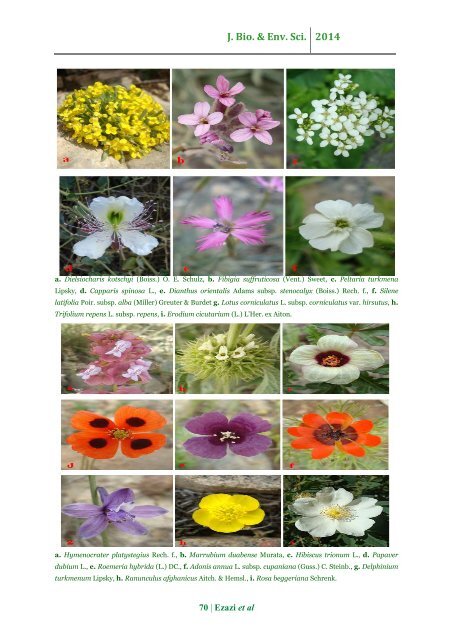The flora of Saluk National Park, Northern Khorassan province, Iran
Abstract Saluk National Park is located in Northern Khorassan province, NW Esfarayen between 37˚ 07΄- 37˚ 14΄ N and 57˚ 10΄- 57˚ 17΄ E. A total of 1137 plant specimens during 2007–2009 were collected and 505 taxa (species, subspecies and varieties), belonging to 296 genera and 71 families were identified. The largest families in the area are Asteraceae (80 taxa), Poaceae (46 taxa), Fabaceae (45 taxa) and Brassicaceae (42 taxa) respectively. The most diverse genera include Astragalus (25 species), Cousinia (12 species), Allium and Alyssum (each with seven species) and Veronica (six species) respectively. The life form rates of the taxa were as follows: Hemichryptophyte (36.7%), Therophyte (34.4%), Chamaephyte (11.3%), Geophyte (9.7%) and Phanerophyte (7.9%). From the standpoint of vegetation type, 56.2% of the chorotypes belong to Irano-Turanian vegetative elements. The results show that 31 taxa (6.1%) are endemics and 36 taxa (7.1 %) exist in the IUCN list. During this reaserch one species “Senecio joharchii (Asteraceae: Senecioneae)” is presented as new species to science and three species are recorded for the first time from Iran.
Abstract
Saluk National Park is located in Northern Khorassan province, NW Esfarayen between 37˚ 07΄- 37˚ 14΄ N and 57˚ 10΄- 57˚ 17΄ E. A total of 1137 plant specimens during 2007–2009 were collected and 505 taxa (species, subspecies and varieties), belonging to 296 genera and 71 families were identified. The largest families in the area are Asteraceae (80 taxa), Poaceae (46 taxa), Fabaceae (45 taxa) and Brassicaceae (42 taxa) respectively. The most diverse genera include Astragalus (25 species), Cousinia (12 species), Allium and Alyssum (each with seven species) and Veronica (six species) respectively. The life form rates of the taxa were as follows: Hemichryptophyte (36.7%), Therophyte (34.4%), Chamaephyte (11.3%), Geophyte (9.7%) and Phanerophyte (7.9%). From the standpoint of vegetation type, 56.2% of the chorotypes belong to Irano-Turanian vegetative elements. The results show that 31 taxa (6.1%) are endemics and 36 taxa (7.1 %) exist in the IUCN list. During this reaserch one species “Senecio joharchii (Asteraceae: Senecioneae)” is presented as new species to science and three species are recorded for the first time from Iran.
Create successful ePaper yourself
Turn your PDF publications into a flip-book with our unique Google optimized e-Paper software.
J. Bio. & Env. Sci. 2014<br />
a. Dielsiocharis kotschyi (Boiss.) O. E. Schulz, b. Fibigia suffruticosa (Vent.) Sweet, c. Peltaria turkmena<br />
Lipsky, d. Capparis spinosa L., e. Dianthus orientalis Adams subsp. stenocalyx (Boiss.) Rech. f., f. Silene<br />
latifolia Poir. subsp. alba (Miller) Greuter & Burdet g. Lotus corniculatus L. subsp. corniculatus var. hirsutus, h.<br />
Trifolium repens L. subsp. repens, i. Erodium cicutarium (L.) L’Her. ex Aiton.<br />
a. Hymenocrater platystegius Rech. f., b. Marrubium duabense Murata, c. Hibiscus trionum L., d. Papaver<br />
dubium L., e. Roemeria hybrida (L.) DC., f. Adonis annua L. subsp. cupaniana (Guss.) C. Steinb., g. Delphinium<br />
turkmenum Lipsky, h. Ranunculus afghanicus Aitch. & Hemsl., i. Rosa beggeriana Schrenk.<br />
70 | Ezazi et al





![Review on: impact of seed rates and method of sowing on yield and yield related traits of Teff [Eragrostis teff (Zucc.) Trotter] | IJAAR @yumpu](https://documents.yumpu.com/000/066/025/853/c0a2f1eefa2ed71422e741fbc2b37a5fd6200cb1/6b7767675149533469736965546e4c6a4e57325054773d3d/4f6e6531383245617a537a49397878747846574858513d3d.jpg?AWSAccessKeyId=AKIAICNEWSPSEKTJ5M3Q&Expires=1716678000&Signature=XjfpznaDm9AXJedSVQka1dVoVwA%3D)












